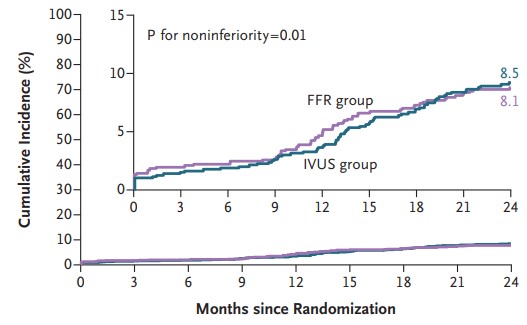Korea-China research team presents international guidelines for coronary artery stenosis stent treatment
- There was no difference in fractional blood flow reserve(FFR) and intravascular ultrasonography(IVUS) when deciding on stenting for coronary artery stenosis
- Korea-China joint research team led by SNUH reveals the results of a large-scale multinational clinical study conducted over 10 years
After a decade of research, the results of a large-scale, multinational clinical study that can serve as an international guideline for the diagnosis and treatment of coronary artery stenosis were published in NEJM (New England Journal of Medicine, IF 176.079).
On September 1st, a joint research team led by Prof Koo Bon-Kwon & Prof Kang Jeehoon of Seoul National University Hospital, Prof Tahk Seung-Jea of Ajou University Hospital, and Prof Wang Jian'an of China conducted a study at 18 institutions in Korea and China, published in the world's best medical journal called NEJM. As a result, an answer to the effects of a diagnostic and treatment aid tool for coronary artery stenosis, which has not been verified so far, was presented.
It was found that there was no difference in clinical effect between patients who underwent the 'fractional blood flow reserve test(FFR)' and intravascular ultrasonography(IVUS)' as adjunctive tools for coronary artery stenosis procedures.
Before the study, there was an opinion that the FFR(measurement of reduced blood flow due to stenosis) was inferior to the IVUS(ultrasonography to determine the shape of arteriosclerosis or the size of the inner diameter of blood vessels). However, the results of the study showed that the efficacy of the two guide tools was the same.
The results were confirmed on the 1st of September after comparing the clinical effects of the FFR and IVUS in 1,682 patients with moderate coronary artery stenosis.
Coronary artery stenosis is caused by the narrowing of the coronary arteries that supply blood to the heart muscle. If you have this disease, the degree of coronary artery stenosis is determined through coronary angiography, a standard test method, and treatment such as stent insertion is performed if the stenosis is severe.
However, it is difficult to determine the need for stent insertion and the appropriate type of stent by confirming the exact degree of vascular stenosis with this test alone. For sophisticated diagnosis and treatment, various auxiliary examination tools are used together.
The most commonly used auxiliary tools are the FFR, which measures reduced blood flow due to stenosis, and the IVUS, which uses ultrasound to check the shape of arteriosclerosis or the size of the inner diameter of blood vessels.
Both tools are evaluated to have advanced the treatment of patients with coronary artery disease, but the FFR is considered the standard for evaluating the degree of coronary artery stenosis. However, as rumors about the superiority of IVUS emerged, these standard guidelines were questioned.
Until now, there has been no study that directly compared the adjuctive tools used for the diagnosis and treatment of coronary artery stenosis. To clarify the standard treatment guidelines for coronary artery stenosis, the research team planned a multicenter, multinational clinical study (FLAVOUR) to compare the effects of the FFR and IVUS.
The research team conducted the hypothesis that the FFR group was non-inferior to the the IVUS group.
A total of 1,682 patients with moderate coronary artery stenosis from 18 institutions in Korea and China participated in the study. The average age was 65 years, and 30% of the patients expressed acute coronary syndrome. The research team divided all patients into a the FFR group and the IVUS group through 1:1 random assignment.
The medical staff in charge of each patient determined the need for stent implantation using coronary angiography, assigned adjunctive tools for each patient and analyzed the adequacy of stent implantation.
As a result, the FFR group had a 43% lower frequency of stent insertion than the IVUS group. The frequency of prescriptions for antiplatelet drugs was also 19% lower, meaning instances of both stenting and medication treatments were reduced.

[Figure] Comparison of clinical event rates in the fractional flow reserve (FFR) and intravascular ultrasonography (IVUS) groups.
1682 patients were randomized 1:1 to the FFR group and the IVUS group and followed up for a total of 2 years. As a result, the incidence of clinical events was 8.1% in the FFR group and 8.5% in the IVUS group, indicating the non-inferiority of the FFR group.
Despite this relatively lower rate of procedures and medications, the follow-up results on the incidence of clinical events (death, myocardial infarction, revascularization, etc.) over 2 years were similar for the FFR and IVUS groups at 8.1% and 8.5%, respectively.
The incidence of individual clinical events was also not different between the two groups. Symptoms and quality of life, which were subjectively evaluated by the patients through the SAQ questionnaire, were similar in both groups.
In other words, unlike the existing opinion that the FFR was inferior to IVUS, non-inferiority was proven, as the research team had hypothesized.
Professor Kang Jeehoon said, “There has never been a study that directly compared and analyzed the efficacy of the two tools, despite their clinical importance. As a large-scale randomized clinical study, this work is meaningful.” He continued on the study’s significance, remarking, "This study is significant as it is the world's first large-scale randomized clinical study comparing the clinical effects of diagnosis and treatment tools in patients with coronary artery disease.”
Professor Koo Bon-Kwon said, "The results of the FLAVOUR study contributed to the establishment of international treatment guidelines by comparing the clinical effects of FFR and IVUS." He remarked, "In the future, we plan to further analyze what factors cause clinical events in coronary artery disease, which test tools are useful in terms of cost-effectiveness, and what differences exist in high-risk patients."

[Pictures from left] Seoul National University Hospital Department of Cardiology, Prof Koo Bon-Kwon & Prof Kang Jeehoon